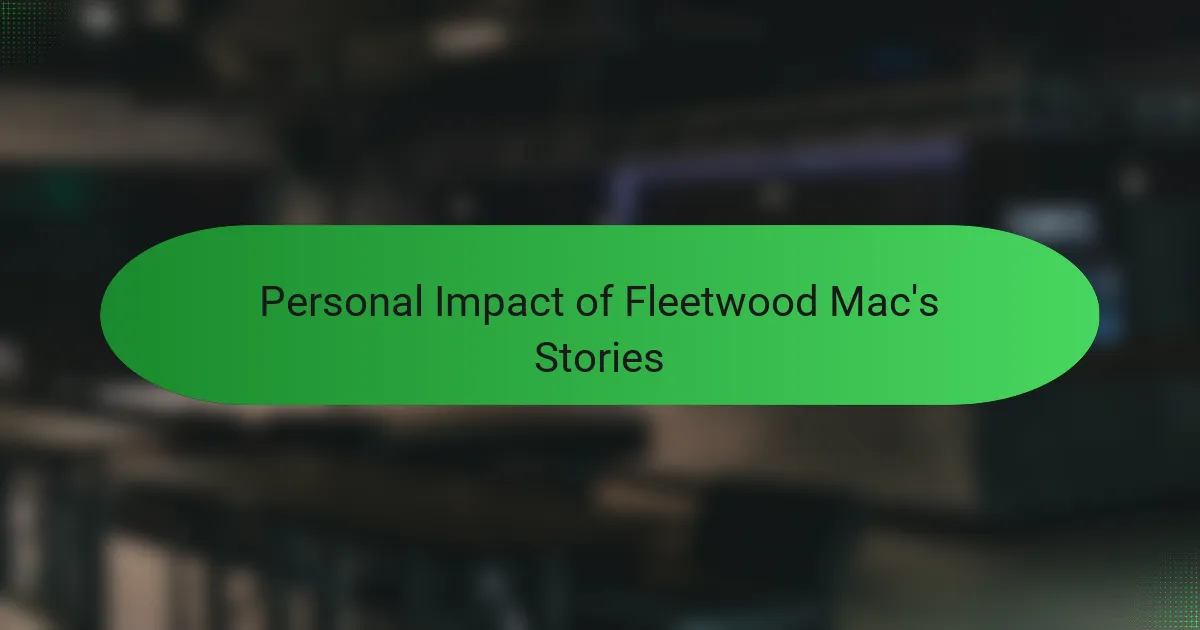Key takeaways
- Fleetwood Mac’s music blends rock, pop, and folk, characterized by emotional storytelling and intricate melodies that resonate with listeners.
- The band’s evolution and personal dynamics are reflected in their lyrics, exploring themes of love, identity, and emotional turmoil.
- Techniques such as shifting perspectives and symbolically rich narratives create layers of meaning that invite deeper listener engagement.
- Applying Fleetwood Mac’s storytelling in fan content can enhance emotional depth, encouraging creators to express complex ideas and feelings through their work.

Understanding Fleetwood Mac’s Music Style
Fleetwood Mac’s music style is a fascinating blend of rock, pop, and folk that feels both timeless and deeply personal. When I first listened to their songs, I was struck by how their melodies seem to carry entire stories, almost like journal entries set to music. Have you ever noticed how their harmonies create a sense of intimacy, making you feel like you’re part of their journey?
What I find especially compelling is how the band’s sound evolved over time, reflecting the complex relationships between its members. Their style isn’t just about catchy tunes; it’s a raw emotional expression that draws you in. Listening to them, I often wonder how much of their real-life experiences shaped those haunting melodies and heartfelt lyrics.
There’s also a unique mix of softness and grit in their music—a delicate balance that pairs Stevie Nicks’s mystical vocals with Christine McVie’s soulful piano and Lindsey Buckingham’s intricate guitar work. This combination creates layers that invite listeners to keep discovering something new with every play. It’s no wonder their style still resonates so deeply with fans like me, decades later.

Exploring Storytelling in Rock Bands
Storytelling in rock bands often goes beyond just the lyrics; it’s woven into the very fabric of the music. I’ve always been fascinated by how bands use sound to paint vivid emotional landscapes, making each song feel like a chapter in a larger saga. Have you ever caught yourself lost in a riff or a melody that seemed to tell a story all on its own?
What sets great storytellers apart in rock is their ability to connect personal experiences with universal themes. From heartbreak to rebellion, these stories resonate because they tap into emotions we’ve all felt but might not always express. In my experience, when a band masterfully balances narrative and music, it creates a powerful intimacy that pulls you into their world.
I remember attending a live show where the lead singer shared the inspiration behind a song—it completely changed how I heard it afterward. Moments like that remind me that storytelling in rock isn’t just about entertainment; it’s about forging a genuine connection with the audience. Have you had a similar experience where a song’s backstory transformed your entire perspective?

Key Themes in Fleetwood Mac’s Lyrics
Fleetwood Mac’s lyrics dive deep into themes of love, loss, and emotional turmoil. I’ve always been struck by how their songs don’t just tell a story—they reveal raw, vulnerable feelings that feel incredibly relatable. Have you noticed how tracks like “Landslide” and “Go Your Own Way” capture the highs and lows of relationships with such honesty?
What fascinates me even more is their exploration of personal identity and change. Listening to their music, I often think about how the shifting dynamics within the band itself fueled lyrics full of introspection and resilience. In a way, their songs become reflections on growth and the sometimes painful process of moving forward.
There’s also this haunting quality in their storytelling, a blend of hope and melancholy that lingers long after the song ends. That mix always pulls me in, making me wonder how they balance such emotional complexity so effortlessly. Have you ever found yourself replaying a Fleetwood Mac track just to unpack all the feelings it stirs up?

Techniques Used in Their Songwriting
One technique that always grabs my attention is their use of shifting perspectives within a single song. It’s like Fleetwood Mac lets you eavesdrop on different band members’ viewpoints, which adds layers of emotional depth. Have you ever felt like you’re caught in a conversation that’s both personal and universal at the same time? That’s exactly the effect this approach creates for me.
Another thing I find fascinating is their ability to combine simple, catchy melodies with complex emotional narratives. Lindsey Buckingham’s intricate guitar patterns often contrast beautifully with Stevie Nicks’s haunting vocal delivery, creating a push and pull that mirrors the tension in the lyrics. This delicate balance keeps me hooked, wondering what feelings I’ll uncover on the next listen.
Lastly, their storytelling leans heavily on metaphor and symbolism, which invites listeners to interpret songs in their own way. I remember the first time I realized “Rhiannon” wasn’t just a name but a mystical image woven throughout the song—it completely changed how I connected with their storytelling. Don’t you just love when a song reveals itself in layers like that?

Personal Impact of Fleetwood Mac’s Stories
Fleetwood Mac’s stories have left a lasting mark on me, often surfacing during moments when I least expect it. I remember driving late at night, their lyrics echoing in my mind, making me reflect on my own experiences with love and loss. Have you ever had a song feel so personal it’s almost like it’s narrating your own life?
What truly resonates is how their storytelling captures emotions so honestly, it feels like someone is gently confiding in you. There’s a vulnerability in their narratives that reminds me it’s okay to feel messy and complicated. That kind of connection is rare, and I cherish it deeply every time I listen.
Sometimes, I find myself revisiting their songs to find new meaning, especially during tough times. It’s as if Fleetwood Mac’s stories grow with me, offering comfort and understanding when I need it most. Have you noticed how some songs seem to age alongside you, revealing fresh insights with every stage of life?

How to Analyze Their Storytelling
When I analyze Fleetwood Mac’s storytelling, I start by paying close attention to how their lyrics intertwine with the band’s emotional dynamics. It’s fascinating to me how much the personal relationships within the group shape the narrative voice in their songs. Have you ever caught yourself wondering whose perspective you’re hearing at any given moment?
Next, I try to unpack the symbolism and metaphors they use—there’s often more beneath the surface than the first listen reveals. For instance, noticing how a name or image might represent something mystical or deeply personal completely changed how I experienced certain tracks. Do you find that peeling back these layers makes the stories more meaningful?
Finally, I listen for the musical cues that emphasize the storytelling—shifts in tone, harmony, or instrumentation all add emotional weight. It’s like the music itself is telling a parallel story that amplifies the lyrics. When you pick up on these subtle details, doesn’t the whole song feel more alive and intimate?

Applying Their Storytelling in Fan Content
Applying Fleetwood Mac’s storytelling techniques to fan content opens up exciting possibilities. When I create fan art or write about their songs, I try to layer multiple perspectives, much like they do with shifting viewpoints in their lyrics. It makes the fan work feel more dynamic and emotionally honest, don’t you think?
I’ve also found that embracing metaphor and symbolism in fan interpretations deepens the connection. Instead of just describing events, I’ll use images or subtle hints to evoke the feelings behind the story—just like Fleetwood Mac’s songs invite us to do. Have you ever noticed how this approach invites others to see their own meaning in your content?
Another thing I appreciate is balancing simplicity with emotional complexity. Whether I’m writing a blog post or making a playlist, I aim to capture that delicate blend of raw feeling and catchy expression that keeps fans coming back. It’s a challenge, but also what makes fan creations truly resonate. How do you bring that kind of emotional balance into your own fan work?